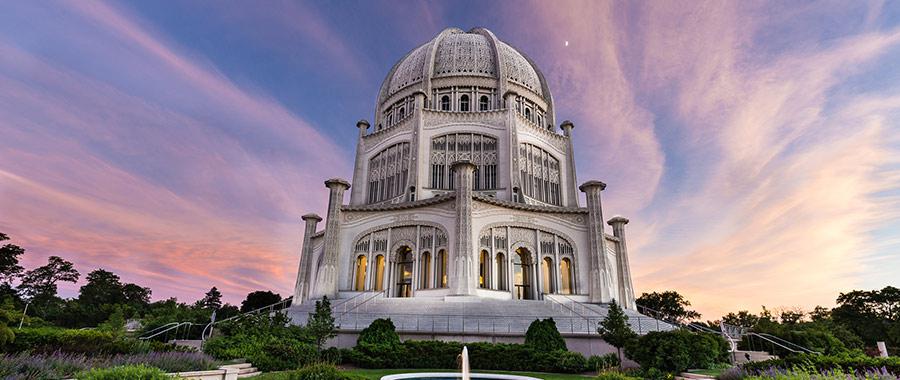In an era increasingly characterized by the cacophony of superficial engagements, the Baha’i House of Worship emerges as a sanctuary of reflection and profound exploration. This architectural ode to spirituality serves as more than a mere edifice; it embodies the limitless virtues of the Baha’i teachings, beckoning visitors to delve into the immeasurable potentialities that lie within. Such sites not only provide a physical locus for worship but also catalyze the essence of spiritual connectivity, community harmony, and the dawning of transformative insights.
Visiting a Baha’i House of Worship is akin to embarking upon a pilgrimage of the soul. Each structure is designed to transcend geographic and cultural boundaries, beckoning individuals from various walks of life. This inclusivity fosters a universal dialogue among diverse ideologies, contributing to a richer understanding of humanity’s collective spiritual quest. The distinguishing architectural elements—often featuring nine-sided designs—symbolize the unity of the world’s religions, evoking a mystical number steeped in significance throughout various cultures.
The experience of navigating through the sacred space begins with an anticipation that reverberates in the heart and mind. Upon entry, one is enveloped in an ambiance imbued with tranquility—an intentional space that invites silence and introspection. The softly filtered light that cascades through ornate windows serves as a metaphorical reminder of enlightenment: illumination punctuating the shadows of doubt. Here, the whispers of contemplative prayer mingle harmoniously with the distant hum of communal resolve, creating an ethereal cacophony that is both soothing and invigorating.
Each visit offers a multitude of opportunities for spiritual enrichment, making palpable the Baha’i emphasis on personal quest and exploration. The House of Worship is not merely a center for liturgical gatherings; it is an intellectual crucible where doctrines and principles disseminate freely. The exhibit of texts, teachings, and artifacts invites exploration and contemplation, allowing one to grapple with profound questions of existence: “Who am I in the tapestry of life? What does it mean to serve? How can I contribute to the betterment of humanity?”
Moreover, the communal aspect of these revered sites accentuates the significance of collective endeavors in pursuit of spiritual aspirations. Visitors often find themselves immersed in the shared experiences of others, crafting an unspoken bond that transcends verbal communication. In this hallowed space, the differences that often divide us seem trivial, overshadowed by a collective yearning for unity. The opportunity for interfaith dialogue is cultivated naturally; casual conversations can blossom into profound exchanges laden with insights that challenge preconceived notions.
The symbiotic relationship between the House of Worship and its visitors extends beyond passive engagement. Individuals are encouraged to participate in community activities, enhancing their sense of belonging while simultaneously broadening their perspectives. Seminars, arts exhibitions, and musical performances resonate within these sacred walls, illuminating the endless possibilities of human creativity. Thus, every visit metamorphoses into an avenue for self-discovery, inspiring individuals to harness their innate capabilities to contribute meaningfully to the world.
In traversing the sacred corridors of a Baha’i House of Worship, one encounters the sublime intersection of faith and reason. The Baha’i teachings advocate for the harmony of science and religion, positing that both realms serve to elucidate the truths of existence. The discussions that occur within these walls often revolve around the synthesis of intellectual inquiry and spiritual insight. Visitors leave not only with a deeper appreciation for their faith but also a renewed commitment to integrating knowledge into their daily lives. The Baha’i maxim that “the seeker of truth must be like a lion” resonates here, encouraging fervor in the pursuit of wisdom.
Moreover, the meditative design of these spaces guides visitors towards inner contemplation. The interiors of the Houses of Worship often feature serene gardens and sacred architecture, serving as an allegory for spiritual growth. These meticulously chosen elements evoke a sense of nurturing, providing a parallel to the soul’s unfolding journey towards enlightenment. To walk through these gardens is to traverse the pathways of one’s spirit, an invitation to cultivate virtues such as patience, humility, and love.
The articulation of sacred narratives through architectural symbolism offers a lens to perceive one’s journey through life. Much like the layers of paint on a canvas, each experience adds depth and texture, evidencing life’s complexities and the beauty inherent in the human experience. The presence of the Baha’i House of Worship in one’s life acts as a catalyst, urging individuals to peel back the layers of their own existence, prompting them to examine their values, beliefs, and relationships.
In conclusion, the Baha’i House of Worship stands as a beacon of immeasurable potentialities, inviting souls to engage in a transformative pilgrimage of self-discovery and communal harmony. Each visit provides a unique exploration of spirituality, weaving together the diverse threads of humanity into a unified tapestry of understanding. The teachings of Baha’u’llah resonate through the halls, emphasizing the unbroken connection between the individual and the collective, and encouraging an embrace of the extraordinary journey of faith, intellect, and community. Thus, entering a Baha’i House of Worship is not just a visit; it is an odyssey into the vast, uncharted potential that resides within each individual, waiting to be unfurled in the light of collective aspiration.
